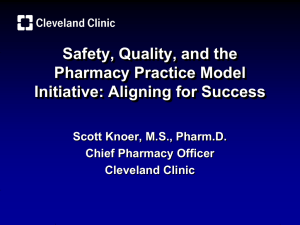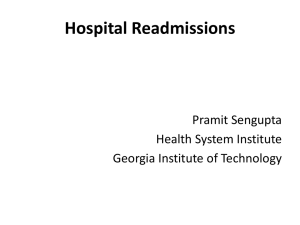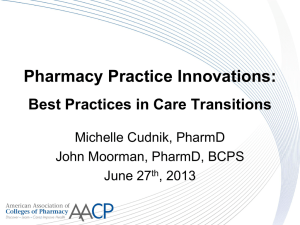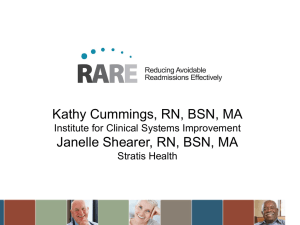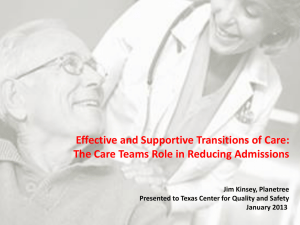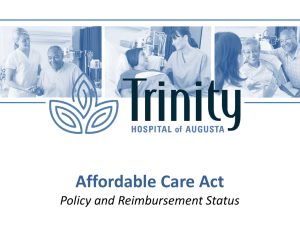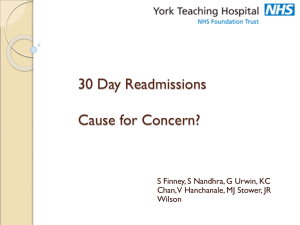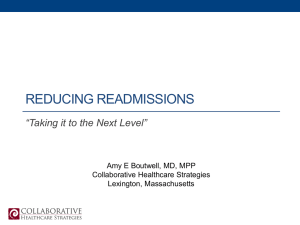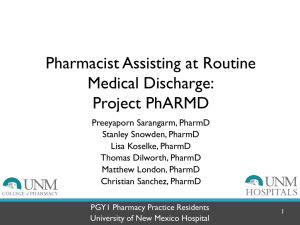Pharmacist Role in a Coordinator Care Delivery System
advertisement
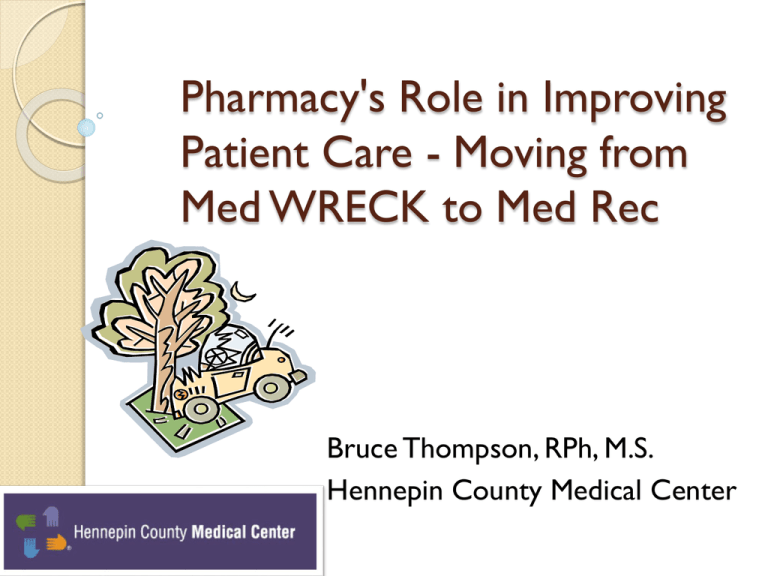
Pharmacy's Role in Improving Patient Care - Moving from Med WRECK to Med Rec Bruce Thompson, RPh, M.S. Hennepin County Medical Center Learning Objectives At the conclusion of the program, the participant will learn: 1. Identify steps to consider reducing patient readmission from a pharmacy perspective 2. Understand the barriers with medication discharge process 3. Adopt a process to develop new services 3 First Project Medication Error on Discharge. Medication Not continued Medication restarted that should not Pilot First 30 patients, only 8 % were Error Free Pilot Added Pharmacists to review Discharge Medication Orders 129 Patients average over 6 months Pilot Step one, Improvements in EPIC Still 70% had potential Errors Pilot Improved Process and Pharmacists improved Readmission Rate by 47% ! Pilot Reduced from 10.2 % to 5.4% Now after 15 months still below 6%. Pilot Added Pharmacists to provide service for all Patients in this category. Slowly Expanded to other high risk areas Next Phase CCDS – Coordinated Care Delivery System Patient Stratification: A blueprint for Reducing Readmissions Stratification Care System Initiative Intervention 3 or more admits in index year Coordinated Care Center Multidisciplinary team based care. The ambulatory ICU Healthcare Home “on steroids” All other hospital admits Discharge Transition Management Time limited case management to assure timely medical follow up and facilitate connection with community based services. All other patients Disease Management Improved PCP engagement ER Diversion Registry management Same day PCP access Community visits Community partners Improve ER to clinic handoffs Tier I Care ZL 53 YO woman transfers to HCMC CCDS Six chronic medical problems (includes DMII) only four meds Complex social issues (joblessness, social isolation, home foreclosure with homelessness) May 2010 Inpatient Psych admit with suicidality Disrupted a multi-year primary care provider relationship Requesting primary care and mental health follow-up Meeting mental health needs a challenge Tier II Care JL 62 YO woman severe alcoholism Heart and nerve toxicity, back pain Independent but vulnerable Admitted 6/17- 6/20 – Failure to thrive Readmission 6/29-7/3 – Cognition assessed, chemical dependency treatment refused Successful Primary Care follow up 6 days after discharge Medication simplification, contact with home RN Now lost to follow up Tier III Care JF 37 YO homeless man Asthma, recent pulmonary embolism Schizoaffective D/O – likely Cocaine abuse – certain Chronic abdominal pain from pancreatitis – possible Nominally involved in chemical dependency treatment Spring 2010 – 6 admits with $225,000 in charges JF-Changing the Care Paradigm Admit ER IP Clinic Visits Day Contact System Charges (annual) 4/1 – 6/30 8 10 57 1 $225,000 ($900,000) 7/1 – 1/15 1 4 11 35 $35,000 ($65,000) 23 Percent of patients with over 10 active medications Tier I. 46 Percent in Tier II and Tier III have over 10 medications. Tier III care Coordinated Care Center opened mid-July • 100/300 patients assigned • Predominately from inpatient care • Multi-disciplinary team: MDs, NPs, Pharmacist, Social Worker, Care Managers, chemical dependency counselor and Mental health member. • Tier III care Intensive medical care and multidisciplinary care • Low visit volume, high contact/management model • Expensive: 4-5 professional FTEs/150 patients • Twice weekly care team meetings • Reduction in Readmissions • • • Readmission rate reduced by 30-50% Total Hospitalizations reduced by 43%. ER Visits reduced by 37% Pharmacy Role in Reducing Readmissions •Medication Reconciliation •Both Admission and Discharge •Right Medication •Medication Therapy Management •Visits within 5 days of discharge •Routine appointments based on patients •Automatic Refills •Deliver to Clinics, Provider or MTM Med Rec •Proven Success with a program that documented a reduction in readmissions by 47%. • Value realized by Providers MTM Services •Proven Track record with Clinics •Visits increased in past 18 months. •Increased Revenue. •Improved Care •Decrease total Health Care expenses RX Delivery •Adapt process for CCDS Clinic • Auto refill medications •Deliver to clinics to avoid long waits •MTM Pharmacists improve patient compliance. Administrative Approval Pharmacy are integral to the success of the program! Additional Pilots Projects Similar results with Psychiatry and Medicine Where do we go from here? • Get involved with Care Redesign. • Propose MTM services • Evaluate Accuracy of Discharge Medications. • Need Community Pharmacies to work with your health care system. Health-System Pharmacy and Care Transitions Moving from DRG/RVU to ACO Craig Else, PharmD, MHA Fairview Health System Care Transition Models Eric Coleman (www.caretransitions.org) ◦ Four Pillars Medication Self-Management Dynamic Patient-Centered Record Follow-up Red Flags Care Transitions Models (cont’d) Project RED (Re-Engineered Discharge) ◦ 8 similar points ◦ Louise videos ◦ https://www.bu.edu/fammed/projectred/index.h tml BOOST (Better Outcomes for Older Adults through Safe Transitions) ◦ 9P Criteria (Problem Meds, Psych, Polypharmacy, Diagnosis, Health Literacy, Readmissions, Support, Palliative Care) ◦ http://www.hospitalmedicine.org Care Transitions Goals Decreased Readmissions Lower Total Cost of Care Increased Patient Satisfaction Increased Clinical Quality Fairview’s Transition Projects ◦ carol.com/Fairview Ridges ◦ UMMC Pediatrics ◦ FPA/Ucare/Fairview Southdale ◦ MTM/CHF ◦ MTM/Eagan Clinic Fairview Ridges ◦ Facilitated by carol.com ◦ CHF/COPD patients ◦ Pharmacy Discharge Reconciliation and Education ◦ Home Care follow up ◦ MTM follow up Discharge List Examples EPIC Advantages/Disadvantages Want list to be clear, but complete Pictures can be problematic Add/Change/Discontinue section Times? Indication? MD? How does it handle Tapers or Insulin Scales? Pilot Learnings Very few of FRH patients with CHF/COPD were readmissions during pilot Around 50% weren’t associated with Fairview Clinics The clinic care coordinator needs to control the management of these patient populations Communication with hand off information is essential A minimum of 1 home care visit within 2448 hours post hospitalization is necessary to ensure safe transition to home FPA/UCare Two primary interventions ◦ Pharmacy Discharge Reconciliation ◦ Follow up visit with Primary Care within five days Excellent outcomes demonstrated ◦ 30 day readmissions decreased by 42% ◦ Relatively low cost to administer ◦ Expanding to other facilities UMMC Pediatrics Intensive Discharge Reconciliation and Education Post-discharge follow up calls 75% capture rate for prescriptions No readmission data demonstrated yet Excellent customer satisfaction Which Patients? Everyone? High-risk Diagnoses (and high risk for what…)? ◦ CHF/COPD ◦ Pneumonia ◦ AMI High-Risk Medication Therapies or Regimens? Particular Payers? Risk Stratification? Hotspotting “The critical flaw in our health-care system…is that it was never designed for the kind of patients who incur the highest costs. Medicine’s primary mechanism of service is the doctor visit and the E.R. visit. (Americans make more than a billion such visits each year, according to the Centers for Disease Control.) For a thirty-year-old with a fever, a twenty-minute visit to the doctor’s office may be just the thing. For a pedestrian hit by a minivan, there’s nowhere better than an emergency room. But these institutions are vastly inadequate for people with complex problems: the forty-year-old with drug and alcohol addiction; the eighty-four-year-old with advanced Alzheimer’s disease and a pneumonia; the sixty-year-old with heart failure, obesity, gout, a bad memory for his eleven medications, and half a dozen specialists recommending different tests and procedures. It’s like arriving at a major construction project with nothing but a screwdriver and a crane.” New Yorker Article by Atul Gawande http://www.newyorker.com/reporting/2011/01/24/110124fa_fact_gawande ETG/ERG Risk Scoring Episode Treatment Groups ◦ Groups various encounters based on disease “episodes” Episode Risk Group ◦ Assigns a “risk score” to each episode based the associated diagnosis Average patient score is 1 ◦ Higher scores are “sicker” patients, lower scores are “healthier” Scores are used to predict future healthcare utilization FRH Risk Score Audit One fine June day 35 30 25 20 15 10 5 0 A B C D E F G H I J K L M N O P Q R S T U V W X Y Z AA BB CC DD EE Readmission Risk vs. ERG Score (n = 100 patients) 35.00% 30.00% 25.00% 20.00% 15.00% 10.00% 5.00% 0.00% % NOT Readmitted within 90 days % Readmitted within 90 days Inpatient Hospitalization TCU/SNF/Home Care/Home Complex Medication Regimen, High DTP Risk Complex Medication Regimen, High DTP Risk Moderate DTP Risk or Specific Drug Therapy Problem Moderate DTP Risk or Specific Drug Therapy Problem Low DTP Risk Low DTP Risk Primary Care Complex Medication Regimen, High DTP Risk Moderate DTP Risk or Specific Drug Therapy Problem Low DTP Risk Questions? bruce.thompson@hcmed.org
